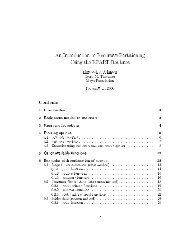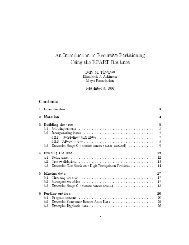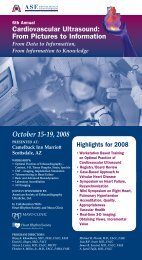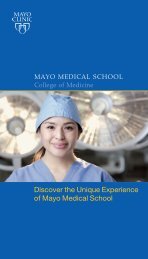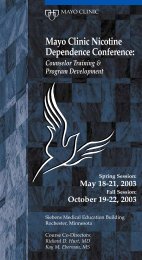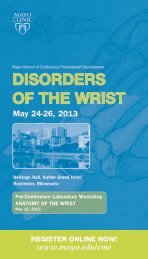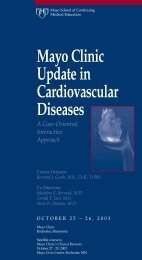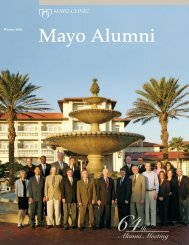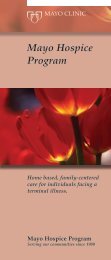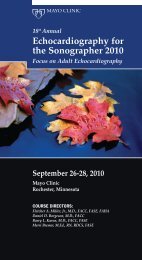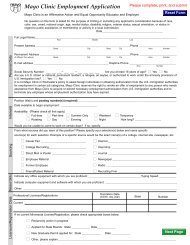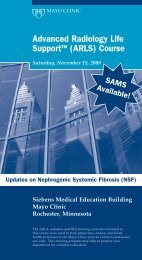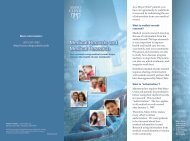Mayo Alumni Magazine 2002 Spring - MC4409-0402 - Mayo Clinic
Mayo Alumni Magazine 2002 Spring - MC4409-0402 - Mayo Clinic
Mayo Alumni Magazine 2002 Spring - MC4409-0402 - Mayo Clinic
Create successful ePaper yourself
Turn your PDF publications into a flip-book with our unique Google optimized e-Paper software.
Caring for athletes<br />
Drs. Dahm and Smith were the first of the foursome at<br />
the Games, arriving a week prior to the Feb. 8 opening<br />
ceremonies. A husband and wife team, they spent opposite<br />
shifts (7 a.m. to 3 p.m. and 3 p.m. to 11 p.m.) at the clinic,<br />
putting finishing touches on the clinic, watching the<br />
athletes arrive, and getting acclimated to the surroundings<br />
and competition venues. The <strong>Mayo</strong> medical team saw a<br />
range of training habits from the athletes.<br />
“Many athletes and coaches were apprehensive about<br />
the drug testing,” says Dr. Smith. “They asked if certain<br />
things were okay for the athletes to take, checking to see if<br />
their paperwork was done correctly. Then we received a<br />
request from a team for therapeutic carbon dioxide. We<br />
couldn’t figure out what they wanted it for, and they<br />
couldn’t explain it. It might have been a language<br />
difference. In the end, we didn’t fill their request.”<br />
The injuries the team saw weren’t uncommon, but the<br />
way athletes were injured was sometimes unique, says<br />
Dr. Laskowski, who worked during the first week of<br />
the Olympics.<br />
“You might see a stress fracture in an aerial skier,” says<br />
Dr. Laskowski. “It’s like a stress fracture you’d see in a<br />
runner, but the skier got it from repeatedly landing jumps<br />
from 30 feet in the air.”<br />
The physicians noted that they cared for many athletes<br />
who had been injured in their final training prior to<br />
competition.<br />
“We had a couple members of the Russian women’s<br />
hockey team who were hurt while practicing against the<br />
men’s team,” says Dr. Dahm. “One had an ankle injury<br />
that was going to keep her out for three weeks. Another<br />
had a severe hematoma in a quad muscle that restricted<br />
her range of motion.”<br />
Dr. Stuart, who worked the final week of the Olympics,<br />
recalled a freestyle skier who came in with an infection at<br />
a fractured clavicle, which had been fixed with a plate and<br />
screws just two weeks earlier. The earlier repair made it<br />
possible for the skier to compete.<br />
“Most people do not subject themselves to that pain<br />
and risk,” says Dr. Stuart. “But that particular athlete had<br />
dedicated himself to this event. You see the frustration that<br />
comes when an athlete can’t compete to the fullest. A luge<br />
racer with a foot injury was very tearful because his event<br />
was the next day. You do your best, but you can’t treat an<br />
injury like that in time for the competition.”<br />
Dr. Dahm said the experience taught them quite a bit<br />
about typical injuries in uncommon sports, such as luge,<br />
skeleton and bobsled. But Dr. Dahm also noted that her<br />
experience at <strong>Mayo</strong> <strong>Clinic</strong> was good preparation for<br />
working with Olympic athletes from many nations.<br />
12 <strong>Mayo</strong> <strong>Alumni</strong> <strong>Spring</strong> <strong>2002</strong>



